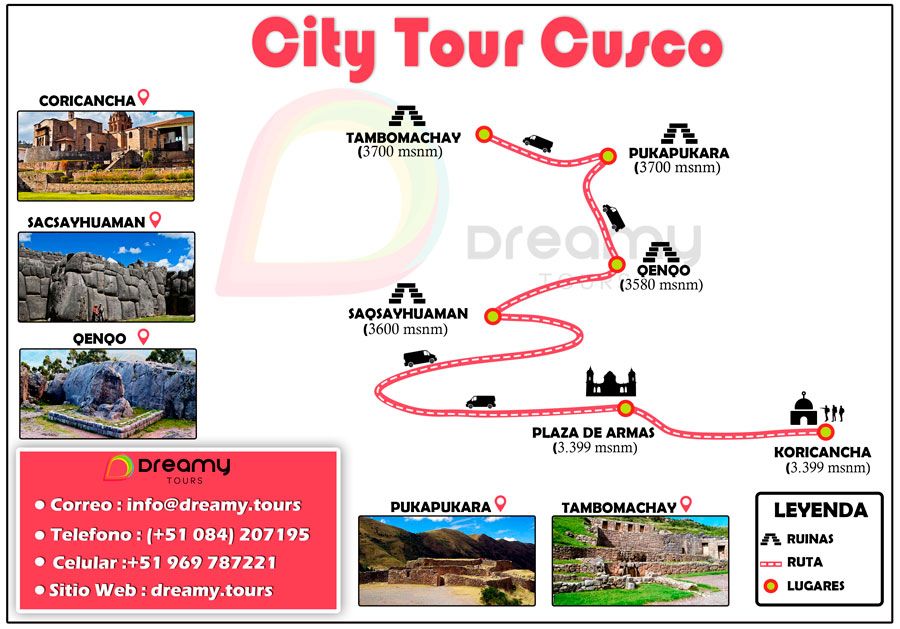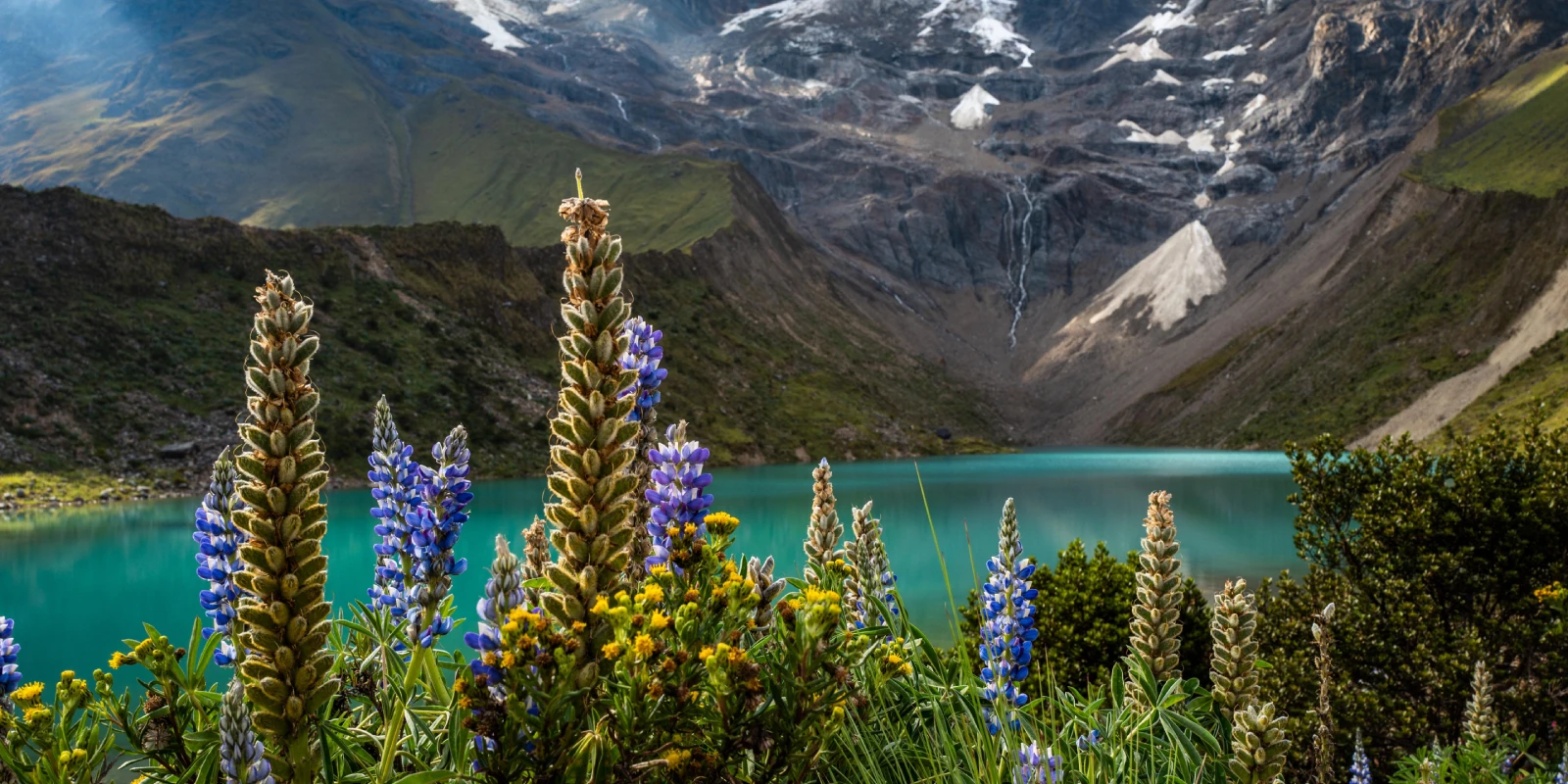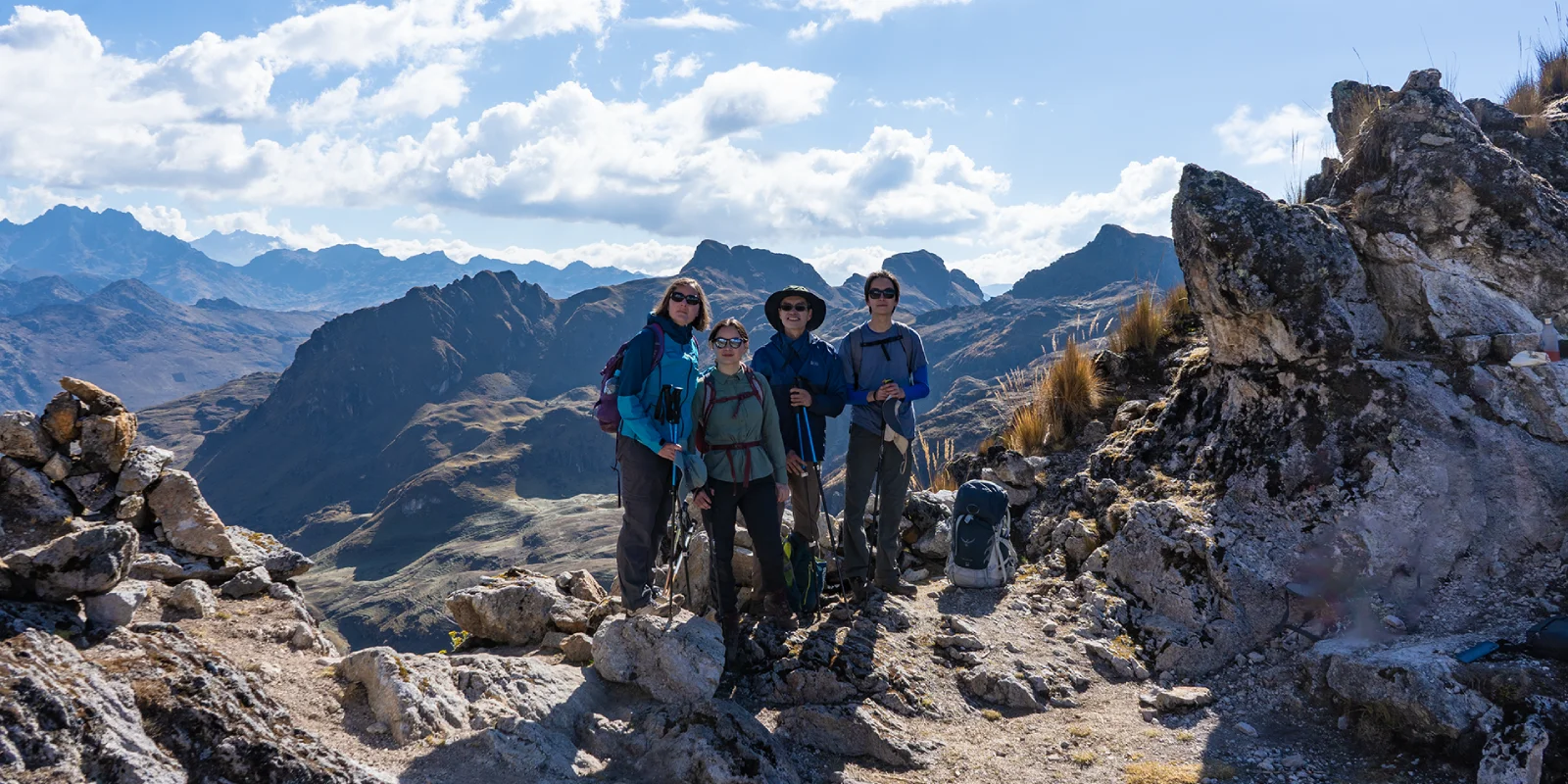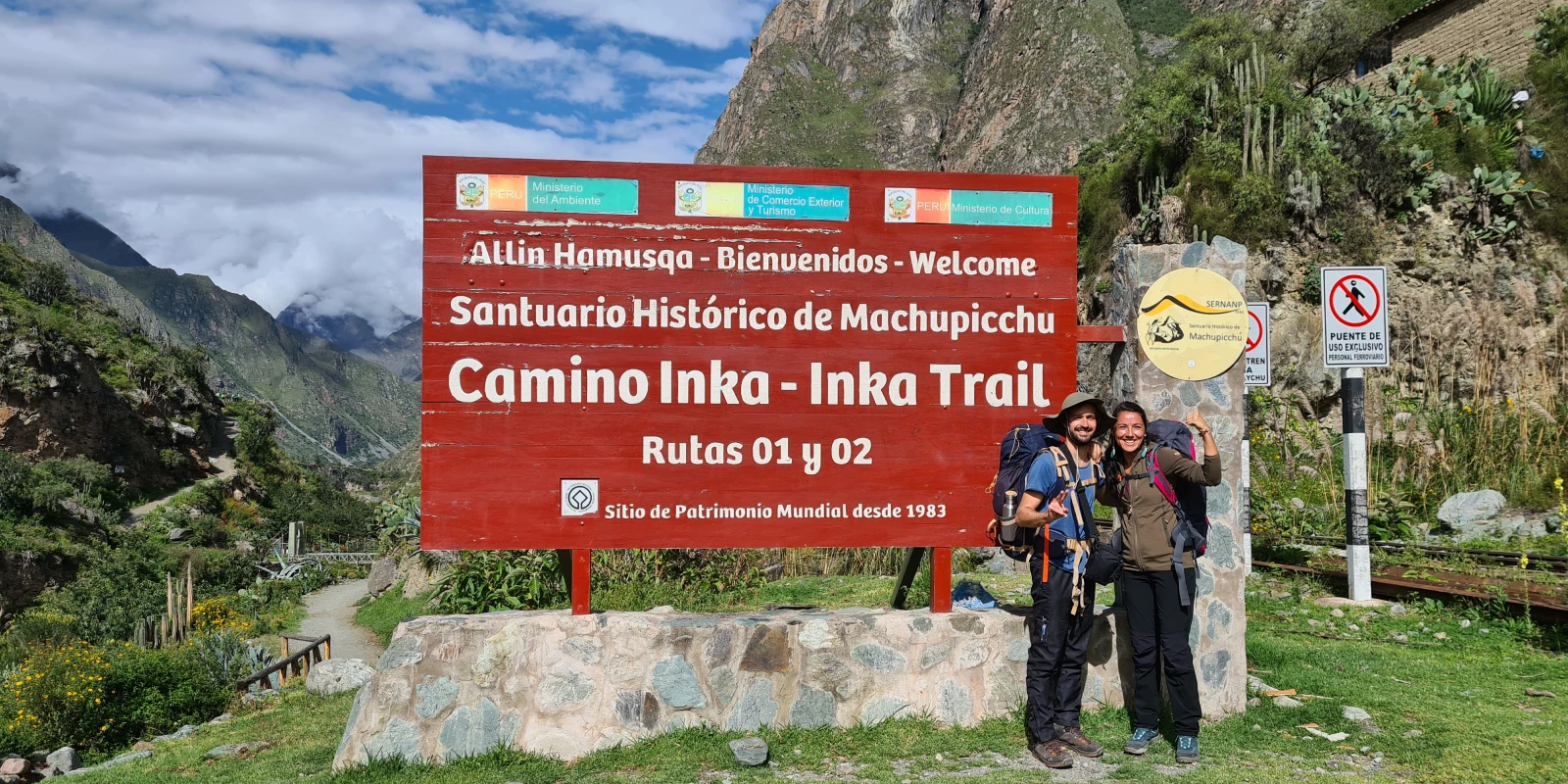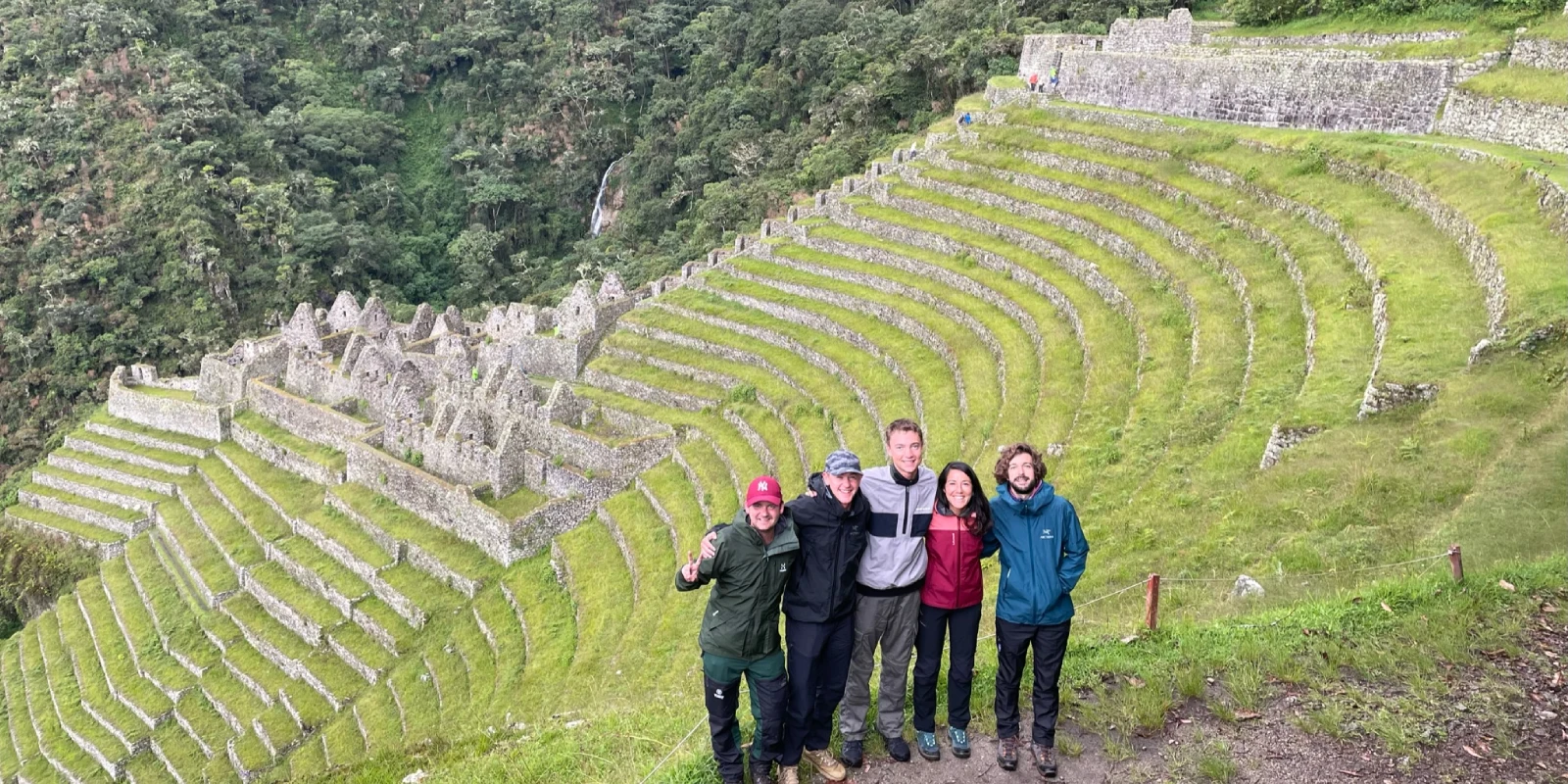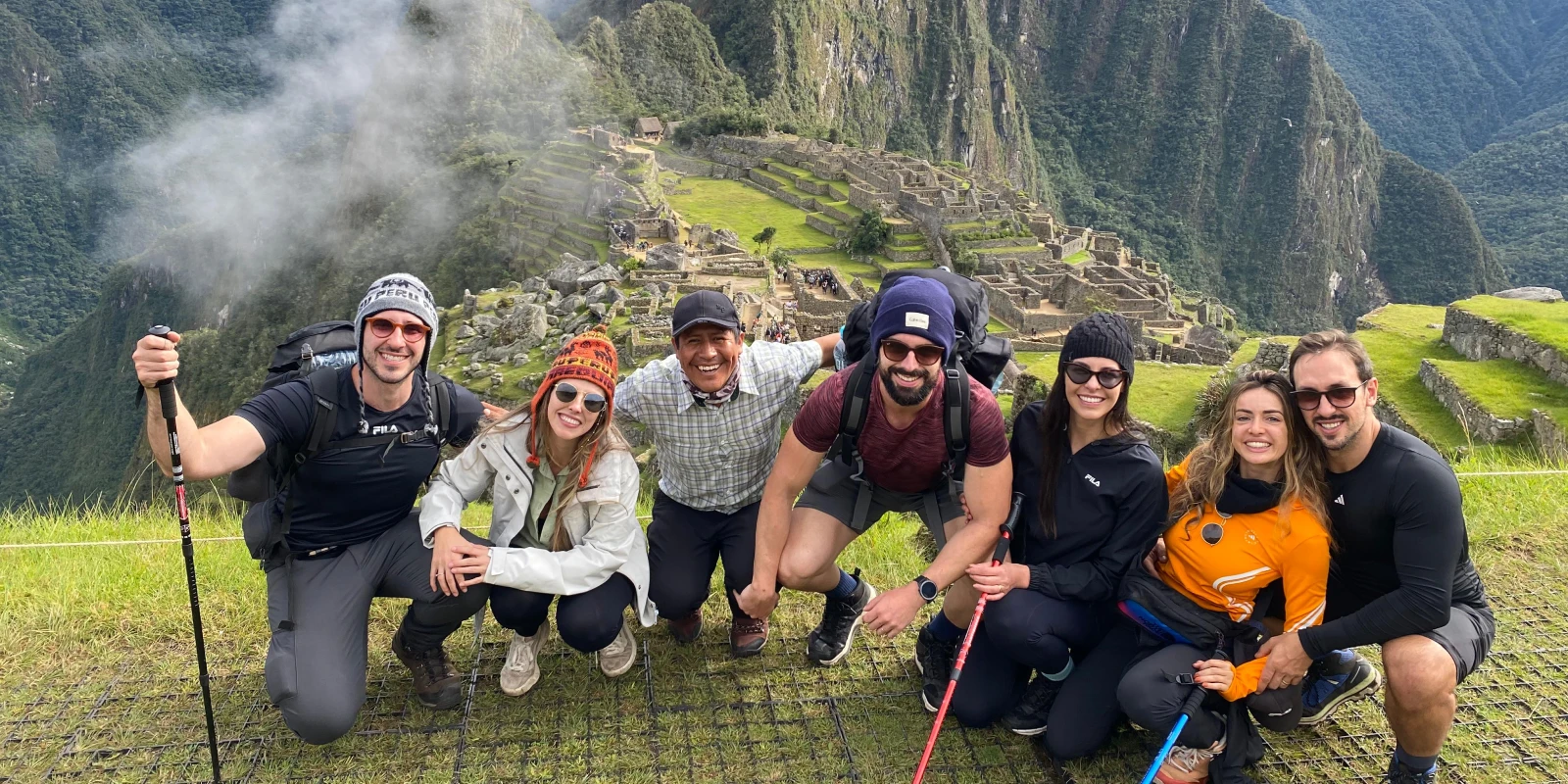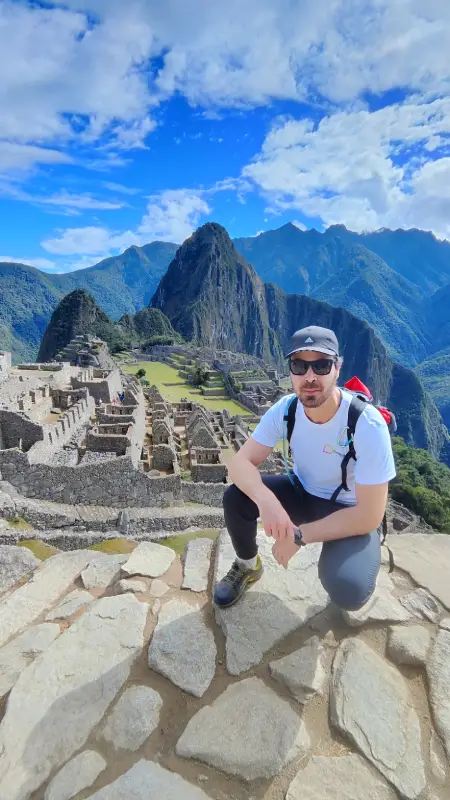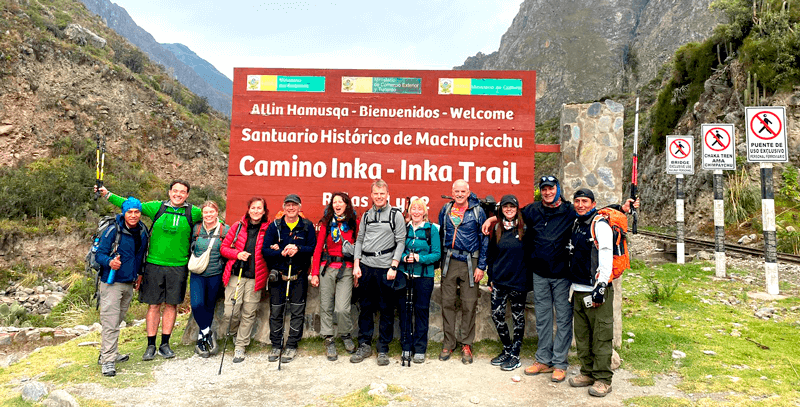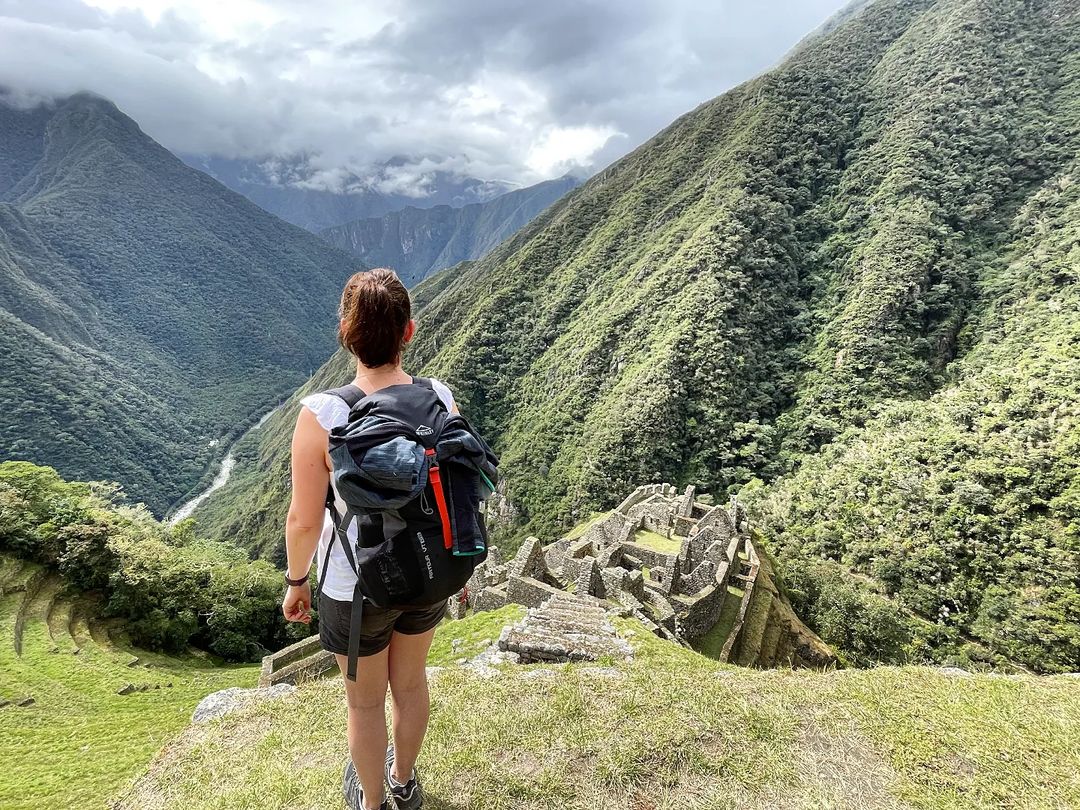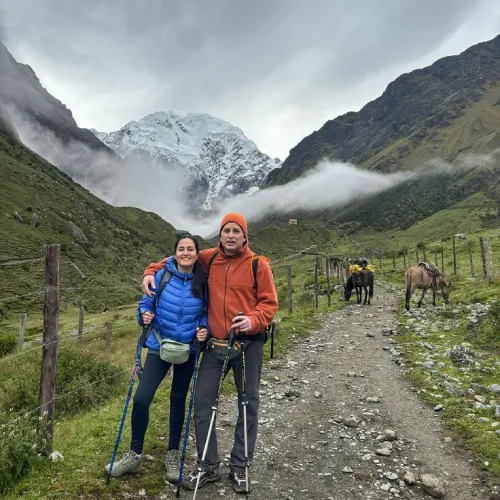Salkantay & Inca Trail in 6 Days: More than a journey, it is a door to personal transformation. An expedition designed for those who are looking for something more than a simple trek, touristic journey.
An expedition where every step tells an ancient story, where landscapes merge with legend, and where your spirit of adventure meets merge with legend, and where your adventurous spirit meets the soul of a lost civilization.
Salkantay: The Giant of the Andes emerges as a titan of stone and ice, offering a trekking experience that defies the imagination. Imagine a route where the landscapes transform with each step, taking you from the imposing glaciers that ascend to 4,650 meters of altitude, to the lush tropical jungle in the same journey.
Each kilometer tells a different story, revealing a unique and impressive biodiversity that changes from rocky moors to the densest green forests.
Inca Trail: The Sacred Route intertwines with this journey like a whisper of history. Here, each path is an original trace left by the ancient Incas, a road that crosses unexplored archaeological ruins, where each stone, each curve of the road is a living testimony of an ancient civilization. It is not just a hike, it is a dialogue with the past, a spiritual connection with one of the most fascinating cultures of humanity.
Overview
Day 1: Cusco – Mollepata (cruz Pata) – Soraypampa – Salkantay Pampa
- 5:30 AM Pickup at your Hotel
- Meals: Lunch and Dinner (optional breakfast in Mollepata)
- Estimated hiking KM: 6 hrs.
- Difficulty: Moderate
- Climate: Cold to Moderate
- Elevation gain: +800 m.
- Highest elevation: 4.200 m.
- Sleepover in Salkantay Pampa
Day 02: Salkantay Pampa – Abra Salkantay – Sisay Pampa
- Meals: Breakfast, Lunch, and Dinner
- Estimated hiking time: 8 hrs.
- Difficulty: Moderate to Challenging
- Climate: warm and cold with mosquitoes
- Sleepover in Sisay Pampa
Day 03: Sisay Pampa – Canal Panama De Inca – Wayllabamba
- Meals: Breakfast, Lunch, and Dinner
- Estimated hiking time: 5hrs.
- Difficulty: Moderate to Easy
- Climate: Warm
- Sleepover in Wayllabamba
Day 04: Wayllabamba – Warmiwanusca – Pacaymayu
- Meals: Breakfast, Lunch, and Dinner
- Estimated hiking time: 6hrs.
- Difficulty: Easy to Moderate
- Climate: warm with mosquitoes
- Sleepover in Pacaymayu
Day 05: Pacaymayu – Runkurakay – Chaquicocha – Wiñayhuayna
- Meals: Breakfast
- Estimated hiking time: 2hrs.
- Difficulty: Easy
- Climate: warm
- Sleepover in Wiñayhuayna
Day 06: Wiñayhuayna – Machu Picchu – Aguas Calientes – Cusco
- Meals: Breakfast
- Estimated hiking time: 2hrs.
- Difficulty: Easy
- Climate: warm
- Transportation back to Cusco
Itinerary
Day 01: Cusco – Mollepata (Cruz Pata) – Soraypampa – Salkantay Pampa
Our exciting trekking route will start early in the morning, departing from the historic city of Cusco at 5:45 am. Initially, we will cross the picturesque village of Mollepata, located at an altitude of 3000 meters above sea level.
Afterwards, we will head towards Cruz Pata, a strategic point located at an altitude of 3400 meters, where we will regroup with the other members of our expedition.
Next, we will undertake a fascinating hike through an impressive Andean valley, surrounded by majestic snow-capped mountains that will provide us with a spectacular landscape. Among the imposing glaciers that will adorn our journey, two colossi stand out: the Nevado Humantay, with a height of 5217 meters, and the impressive Nevado Salkantay, which rises to 6264 meters above sea level.
At the end of our journey, we will set up our camp in Salkantay Pampa, located at an altitude of 3900 meters, where we can rest and enjoy the impressive mountain landscapes.
Important details of the route:
*Transport time: Approximately 4 hours.
*Hiking time: Estimated at 6 hours.
*Weather conditions: Moderate temperature during the day, with a low temperature and cold environment at night.
ADDITIONAL OPTION:
For the most enthusiastic adventurers, we recommend an optional extension to Soray Pampa. This additional route, with an approximate duration of 2 hours, will allow us to visit the spectacular Humantay Lake and see the majestic Humantay Snow-capped mountain up close.
The trail route involves an ascent from Soray Pampa (3900 meters) to reach the altitude of 4220 meters, where the snow-capped mountain is located.
Day 2. Salkantay Pampa – Chiriasqa Inca Pass – Sisay Pampa
After enjoying a comforting breakfast, we will begin our second stage of trekking mid-morning, preparing to face one of the most impressive challenges of our journey through Machu Picchu Park: the ascent to the legendary Chiriasqa Inca Pass.
This highlight of our route is located at an impressive height of 5200 meters above sea level, offering a unique panoramic perspective. From this privileged location, we will delight in a spectacular view of the majestic Salkantay Snow-capped mountain, an imposing peak that rises to 6264 meters, dominating the Andean landscape with its imposing presence.
Afterwards, we will begin a gradual descent towards the picturesque territories of Pampacahuana and Sisay Pampa, located at an altitude of 3700 meters. During our trek, hoke, we will have the opportunity to explore the fascinating vestiges of an ancient Inca canal, thus connecting us with the rich historical heritage of this region.
At the end of our journey, we will set up camp in this charming place, where we will enjoy a well-deserved dinner while contemplating the impressive mountain landscapes that surround us.
IMPORTANT DETAILS OF THE ROUTE:
*Hiking time: Approximately 8 hours of trekking.
*Weather conditions: Moderate temperature during the day, with a drop in temperature and a cold environment at night.
Day 03: Sisay Pampa – Canal Panama De Inca – Wayllabamba
On the third day of our extraordinary expedition, we will begin our journeyearly, at approximately 8:00 in the morning. We will begin a panoramicdescent following the course of the picturesque Pampacahuana River, whose waters will beour faithful companion for several kilometers of our journey.
During this fascinating journey, we will make a strategic stop at the impressive archaeological complex of Incaraqay, also known as Paucarcancha. This important historical site will allow us to explore and admire a series of rectangular constructions, ceremonial plazas and elaborate retaining walls, a testimony to the architectural ingenuity of the Inca civilization.
Continuing our descent, we will finally reach Wayllabamba, a traditional community located at an altitude of 3000 meters above sea level.
This picturesque place will be our resting point and camp for the night, offering a unique natural and cultural environment.
Wayllabamba is not only our final destination for the day, but it will also be the starting point for our next adventure: the emblematic excursion of the Classic Inca Trail, which we will begin at dawn the next day.
CHARACTERISTICS OF THE TRAIL:
*Weather conditions: Moderate temperature during the day, with a cold environment at night. *Walking time: Approximately 5 hours.
Day 4: Challenge And Overcoming – From Wayllabamba To The Pacaymayu Valley
At dawn, specifically around 6:00 in the morning, we will begin one of the most challenging and emblematic stages of our journey along the Inca Trail.
After enjoying a nutritious breakfast in Wayllabamba, we will prepare to face a stretch that will test our physical and mental endurance.
Next, we will undertake a steep and demanding climb that will extend over 9 kilometers, representing the most challenging segment of our trail.
During this intense hike, we will witness an impressive landscape transformation, gradually transitioning from mountain landscapes to the arid and majestic high Andean punas.
Our main objective will be to reach the mountain pass known as Warmiwañusqa, whose significant name translates as “Dead Woman’s Pass.”
This culminating point is located at an impressive height of 4,200 meters above sea level, offering a spectacular panoramic perspective that will allow us to see the imposing Veronica Mountain.
To ensure an optimal journey during this challenging journey, we strongly recommend carrying a backpack well stocked with strategic snacks. Sweets, chocolates and coca leaves will be our fundamental allies to keep our sugar level stable and counteract the effects of altitude sickness.
Once we have overcome this challenging mountain pass, we will begin a gradual descent toward the picturesque Pacaymayu Valley, located at 3,500 meters above sea level. After approximately 6 hours of walking, we will set up our camp in this charming place, preparing to regain our strength and enjoy the majesty of the Andean environment.
CHARACTERISTICS OF THE ROUTE:
*Walking time: Approximately 6 hours of walking
*Weather conditions: Cold environment with significant thermal variations.
Day 5: A Historical Journey Between Ruins And Landscapes – From Pacaymayu To Wiñayhuayna
On the fifth day of our extraordinary expedition, we will immerse ourselves in one of the most fascinating and culturally rich stages of the Inca Trail. After enjoying a comforting breakfast, we will begin a journey that will transport us through archaeological remains and Andean landscapes of incomparable beauty.
Our first stop will be the impressive archaeological site of Runkurakay, an ancient Inca tambo strategically located at 3,800 meters above sea level.
Nestled in a rocky outcrop, this complex will allow us to imagine the life of the Inca travelers who traveled these routes.
Continuing our ascent, we will reach a mountain pass at 3950 meters, from where we will descend towards the enigmatic ruins of Sayacmarca. This extraordinary Inca settlement, whose name suggests “Inaccessible City”, will surprise us with its intricate urban design, composed of a labyrinth of narrow streets, lots, houses, terraces and elaborate hydraulic systems.
Next, our route will take us through an authentic Inca tunnel and a lush forest, until we reach the last mountain pass of our route, located at 3700 meters above sea level. At this point, we will enter the legendary site of Phuyupatamarka, called “The Village on the Clouds”.
Phuyupatamarka will reveal its architectural splendor through circular walls and a still-functional aqueduct system. From this privileged location, we will enjoy a spectacular panoramic view that encompasses the imposing snow-capped peaks and the majestic Urubamba Valley. After this contemplative moment, we will begin a winding descent through a dense bamboo forest.
The highlight of our day will be the arrival at the extraordinary ruins of Wiñay Wayna, an archaeological complex located 2,700 meters above sea level.
Strategically built on a rocky promontory in the middle of a lush forest, this site will offer us incomparable views of the Urubamba Valley.
The Wiñay Wayna complex, whose name means “Eternal Youth”, is characterized by an impressive variety of Inca terraces. A monumental staircase divides the settlement, leading to a ceremonial area of great ritual significance. In this emblematic place we will set up our camp, preparing to live our last night in the depths of the ancient Inca civilization.
CHARACTERISTICS OF THE ROUTE:
*Hiking time: Approximately 8 hours of trekking
*Weather conditions: Moderately cold environment during the day, with the presence of mosquitoes in certain areas.
Day 6: Wiñayhuayna – Machu Picchu – Aguas Calientes – Cusco
We will start early, at 4:30 a.m., with a breakfast that will prepare us for our hike to Inti Punku (Sun Gate;). We will advance along the trail until we reach this impressive viewpoint, from where we will get our first panoramic view of Machu Picchu. In addition, we will have the opportunity to witness the magical sunrise over the citadel.
The final descent to Machu Picchu will take approximately one hour. We will arrive at the citadel (2400 m a.s.l. / 7874 ft) around 8:00 a.m., at which time a 2-hour guided tour will begin. During this tour, we will explore the most emblematic structures and discover the meanings and uses of each one, understanding the historical and cultural importance of this place.
After the tour, we will take a bus to Aguas Calientes village, where you will have free time to visit the famous hot springs. These natural pools are ideal for relaxing and relieving any discomfort after days of hiking.
Finally, we will leave the Aguas Calientes village in the afternoon to return to Cusco.
DAY DETAILS:
*Weather: Warm with presence of mosquitoes.
*Hiking time: Approximately 2 hours.
IMPORTANT NOTE: Departure and arrival times are estimates. Campsites and routes may vary depending on local authority regulations, guide discretion, and group progress.
Included
Tour Includes
- Briefing time at 6pm at our office or hotel, 1 or 2 days before your departure date (must be confirmed at time of booking).
- Private transportation from hotel to Mollepata (Cruz Pata).
- Bus down from Machu Picchu to Aguas Calientes.
- Train from Aguas Calientes village to Cusco/Ollantaytambo by bus.
- Entrance to Salkantay National Park.
- Entrance to Inca Trail and Machu Picchu.
- Professional bilingual guide (Spanish – English speaking guides).
- Camping equipment (professional two-seater tents / single tents: Doite, Kailas 3 model, extra light/4.5kg, Doite, Himalaya model, extra light/4.5kg and Eureka Tents; mats, dining tent equipped with table and chairs).
- Food during the excursion (breakfast, lunch, dinner and snacks/vegetarian option)
- Cook and assistant.
- Rider and mules from Salkantay to Wayllabamba.
- Emergency horse during the hike from Salkantay to Wayllabamba.
- Porters up to 7kg of a client’s personal equipment from Wayllabamba to Machu Picchu.
- First aid kit and oxygen bottle.
Tour Does Not Include
- Breakfast, first day.
- The last lunch in Aguas Calientes.
- The sleeping bag (if you do not have a sleeping bag, there is the possibility of renting one).
Contact Us
General Conditions
- All the rates of our Packages to Peru are expressed in US dollars (optional for currency exchange) and are scheduled per person.
- The valid rates for Peruvians only include IGV.
- All our rates are subject to availability and changes.
- Children under 02 years and 11 months are considered INF (babies), do not pay any service and do not have the right to food, bed or seat on tours.
- DCC (child) is considered a child from 03 to 10 years and 11 months, has a special rate and shares a room with parents.
- Children over 11 years considered adults.
- Minors must travel with an identity document.
- Rates do not apply to holidays, Easter, long weekends, national holidays, Christmas or New Year.
More Information
Salkantay Trek vs Inca Trail
| Classic Inca Trail | Salkantay Trek | |
| Description: | It is known by the name of the Classic Inca Trail, a trek that starts from the Sacred Valley of the Incas and has as its final destination Machu Picchu. | Is an alternative walk to the Traditional Inca Trail, it consists of reaching Machu Picchu through snowy mountains, abundant vegetation, fauna, lagoons and a high-Andean landscape. |
| Duration: | 4 days / 3 nights | 5 days / 4 nights |
| Total Route: | 43 km – 26.72 miles | 65 km – 40.4 miles |
| Starting point: | Km 82, in Huayllabamba | Challacancha town |
| Itinerary: | 1st day: Cusco – Huayllabamba (6-7 hrs.) 2nd day: Huayllabamba – Pacaymayo (7-8 hrs.) 3rd day: Pacaymayo – Wiñaywayna (7-8 hrs.) 4th day: Wiñaywayna – Machu Picchu (2 hrs.) | 1st day: Cusco – Challacancha,(5-6 hrs.) 2nd day: Soraypampa – Challway, (7-8 hrs.) 3rd day: Challway – Playa Sahuayaco, (5-6 hrs.) 4th day: Llactapata – Aguas Calientes, (7-8 hrs.) 5th day: Aguas Calientes – Machu Picchu, (2 hrs.) |
| Difficulty: | Moderate | High |
| Landscape: | From high Andean grasslands to humid tropical forest. | High-Andean, presence of snow-covered areas of potato and corn, valleys, lagoons, cloud forests, waterfalls, hot springs. |
| Flora: | More than 300 species of orchids, shrubs, ichu, straw and typical trees from Inca times. | At first, straw or ichu, crops; then, a characteristic flora of the jungle will appear, as well as coffee, banana, avocado, pineapple and coca leaf crops. |
| Fauna: | Privileged place of endemic species of birds, butterflies, insects. There are also species, such as spectacled bears, vizcachas, lizards, etc. | South American camelids, llamas and guanacos, mainly skunks, vizcachas, in the lakes diversity of aquatic birds, butterflies and fauna of the jungle eyebrow. |
| Climate: | Semi-tropical, hot and humid days, cold nights, rains (from November to April). Minimum 6º C – 11º C (June), Maximum 20º C – 26ºC (June). | Rainy season from November to April, Minimum between 5º C – 11º C (June) in Abra Salkantay, Maximum between 20º C – 26º C (June) in Playa Sahuayaco. |
| Archaeological Attractions: | Patallacta – Pueblo Alto, Warmiñanuska – Dead Woman’s Pass, Runkuracay – Pile of Stones, Sayaqmarca – Dominant Town, Conchamarca – Lodazal, Phuyupatamarca – City on the Clouds, Wiñaywayna – Forever Young, Inti Punku – Puerta del Sol, Inca City of Machu Picchu – Old Mountain. | From Soraypampa to Challway, vestiges of an original Inca Trail. On the fourth day, Llactapata (a resting place) was seen in a Temple located, in front of Machu Picchu. Inca Llacta of Machu Picchu. |
| Entrance Ticket: | Entrance to the Inca Trail route and the Inca City of Machu Picchu. | Entrance to the Sacred City of Machu Picchu. |
| Advantages: | Visit various archaeological centers along the way. Enjoy a varied range of flora and fauna typical of the jungle. Enjoy different climates. It will be a positive and unforgettable experience. Know one of the most visited tourist attractions in Perú. Inca Trail Machu Picchu guarantees the proper execution of your trek. Walk through different ecological floors. | Visit various archaeological centers along the way. Enjoy a varied range of flora and fauna typical of the jungle. Enjoy different climates. It will be a positive and unforgettable experience. Know one of the most visited tourist attractions in Perú. Inca Trail Machu Picchu guarantees the proper execution of your trek. Walk through different ecological floors. |
| Disadvantages: | Income is limited, only 500 people per day. In high season (June – October), tickets are sold out | You need to acclimatize in the City of Cusco, for one or two days before starting the trek. It can give you cold or altitude sickness. |
How high is the Salkantay snow-capped mountain?
The Salkantay snow-capped mountain reaches 6,271 meters above sea level (m.a.s.l.). The trekking route leading to Machu Picchu has its highest point at the ‘Abra Salcantay’, at 4,650 m.a.s.l. From there, the peak of the snow-capped mountain can be seen.
Height of the Salkantay hike
Cusco rises up to 3,400 metres above sea level, which can be a problem for some people, we recommend you to be in Cusco at least 48 hours before starting the trek, during which time you should drink plenty of fluids, avoid alcohol and rest.
The maximum altitude of the Salkantay trek is 4,600m, which is the beautiful Salkantay pass and the minimum altitude of the Salkantay trek is 2,200m at the last camp at Lucmabamba.
The altitude of Salkantay is 6,271 metres above sea level (masl). The highest point is at the ‘Abra Salkantay’, at 4,650 metres above sea level. From there you can see the peak of the snow-capped mountain.
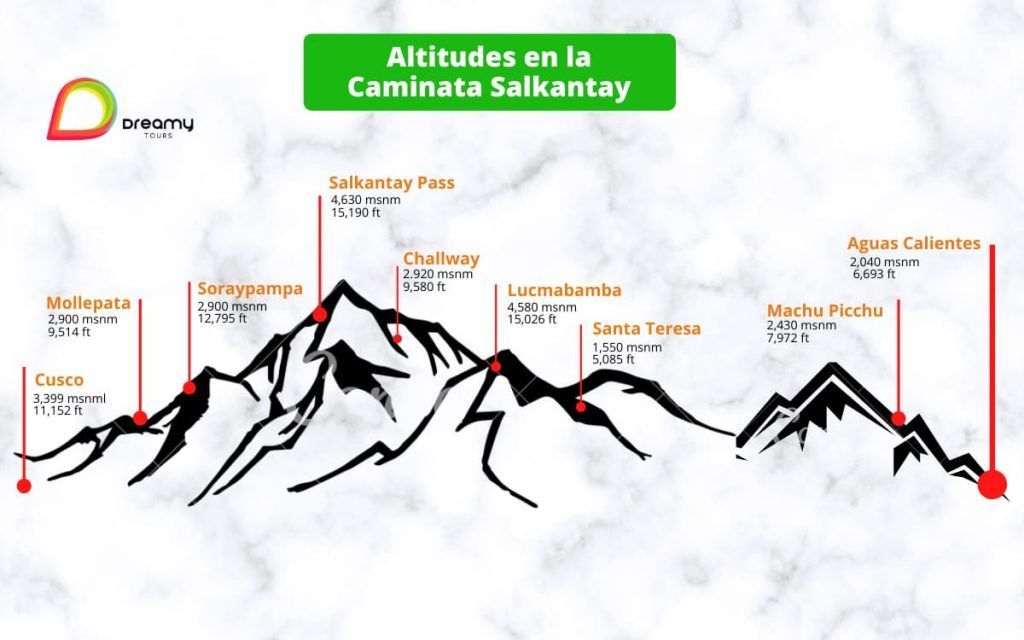
When Is The Best Time to do The Salkantay Trek?
The best time to visit Machu Picchu is in the dry season (April to October). During those months, there is less chance of rain, so the roads are in better condition.
In the dry season, however, the days are sunnier and the nights are cooler. According to mountaineering experts, June, July and August; is the best time to do the Salkantay trek.
| High Temperature °F | Low Temperature °F | |
| Jan | 63 °F | 39 °F |
| Feb | 63 °F | 39 °F |
| Mar | 63 °F | 39 °F |
| Apr | 64 °F | 37 °F |
| May | 64 °F | 32 °F |
| Jun | 64 °F | 28 °F |
| Jul | 63 °F | 27 °F |
| Aug | 64 °F | 30 °F |
| Sep | 64 °F | 34 °F |
| Oct | 66 °F | 37 °F |
| Nov | 66 °F | 37 °F |
| Dec | 64 °F | 39 °F |
Advantages of the Inca Trail:
- Arrives directly at Machu Picchu via the Royal Inca Road, something no other trek offers.
- Every day you can see an impressive number of spectacular ancient ruins.
- Reach Inti Punku, the famous Sun Gate, with a breathtaking view of Machu Picchu at sunrise.
- Stunning landscapes: from snow-capped mountains to fertile cloud forests and lush jungle.
- Well-equipped campsites with good facilities.
- The satisfaction of completing such a world-famous trek.
Tips for the Salkantay Trek:
- Acclimatize for one or two days in Cusco before starting the trek.
- Avoid alcohol or heavy fatty foods. Altitude sickness (soroche) in Salkantay and Machu Picchu is one of the main challenges.
- Do some light exercise before the trek. You don’t need to be in peak physical shape, but some training helps.
- No matter the season, bring warm clothes, especially for the first two nights which are very cold.
- Plan every detail of the trek carefully if you go on your own.
What is the Salkantay Inca Trail?
The term Salkantay Inca Trail is often used to describe the Salkantay Trek as an alternative to the traditional Inca Trail. Although it is not the official Inca Trail, many people call it that because of its popularity and because it also ends at Machu Picchu. It’s an adventure trek that combines raw nature, Andean culture, and access to the citadel—without needing an official permit.
What’s included in the Salkantay Trek to Machu Picchu?
The Salkantay Trek to Machu Picchu is one of the most complete tours in southern Peru. It includes 5 or 6 days of hiking through stunning landscapes: jungle, snow-capped peaks, lagoons, and rural communities. You also get tent accommodations, meals, a bilingual guide, camping gear, transfers, and a guided tour of Machu Picchu at the end. Everything is organized so you can enjoy the trek worry-free.
How long is the 6-day Salkantay Trek?
The 6-day Salkantay Trek lasts exactly 6 days and 5 nights. It’s the most complete version, with a more relaxed pace. It begins in Soraypampa, climbs up to the Salkantay Pass (4,600 m / 15,092 ft), descends into the jungle, and ends in Aguas Calientes. On the sixth day, you visit Machu Picchu. It’s perfect for those who want to enjoy the trek without rushing.
What does the Salkantay Inca Trail tour include?
The Salkantay Inca Trail tour provides everything you need: transfers from Cusco, a professional guide, all meals, tents, sleeping pads, kitchen, pack mules, entrance to Machu Picchu, and train tickets from Santa Teresa or Hidroelectrica. Although it’s not the official Inca Trail, it’s just as meaningful, with unique landscapes and fewer tourists.
What is the Salkantay Trek Peru?
The term Salkantay Trek Peru is simply another way of naming this trek within the country. It’s one of Peru’s most popular treks, especially for travelers seeking adventure, nature, and access to Machu Picchu without relying on Inca Trail permits. It’s located in the Cusco region, but in a more remote area.
What’s the difference between Salkantay vs. Inca Trail?
Inca Trail: follows the original Inca path, with ruins, stone steps, and direct access to Machu Picchu.
Salkantay Trek: wilder and more remote, circling the Salkantay glacier, passing turquoise lagoons and tropical jungle. It doesn’t end with a walk straight into Machu Picchu, but it offers more diverse landscapes and no official permit is required.
What will you see on the Salkantay Trek itinerary?
On the Salkantay Trek itinerary, you’ll witness some of Peru’s most breathtaking sights: the mighty Salkantay snow peak (6,271 m / 20,574 ft), turquoise lakes like Humantay, cloud forests, ancient terraces, and Andean villages. Each day offers something new: high altitudes, jungle heat, and finally, the majesty of Machu Picchu.
What does Salkantay Trek packing list mean?
The Salkantay Trek packing list refers to the essential items you need to bring: thermal clothing, rain gear, trekking boots, backpack, water, snacks, documents, flashlight, and personal items. You don’t need to bring tents or food, since they are provided. A well-prepared list ensures you’re ready.
Where does the Salkantay Trek Peru start?
The Salkantay Trek starts in Soraypampa, about 3–4 hours from Cusco. From there, the hike begins toward the Salkantay Pass. Some variations start in Mollepata or Challabamba, but all follow a similar route through the Vilcabamba mountain range before heading into the jungle and finally reaching Machu Picchu.
What to do in the best season for the Salkantay Trek?
The best season for the Salkantay Trek is from May to October. During this time:
- Book in advance.
- Acclimatize in Cusco.
- Prepare your gear well.
This is when the weather is most stable, views are clear, and trails are in the best condition. It’s also the best time for photos of the Salkantay snow peak without clouds.
Can I take photos at the Salkantay snow peak?
Yes! The Salkantay snow peak is one of Peru’s most photogenic landscapes: the white summit, turquoise Humantay Lake, and the Andes in the background. It’s especially beautiful at sunrise. Just remember to ask before photographing locals, and consider giving a small tip as a thank-you.
What does the combined Salkantay Inca Trail include?
There is no official combined Salkantay Inca Trail, but some agencies offer packages that include both treks separately. For example: you hike the Salkantay Trek, rest for 2 days, and then hike the Inca Trail. It’s a long trip (10–14 days), perfect for those wanting to experience both adventures in full.
Can I take my dog on the Salkantay Trek to Machu Picchu?
No, pets are not allowed on the Salkantay Trek. For safety, environmental, and logistical reasons, only people can do the trek. The terrain is too difficult for animals, and there are no veterinary services along the route. It’s best to leave your pet in good care in Cusco.
What is the best time for the Salkantay Trek?
The best time for the Salkantay Trek is from May to October, during the dry season. During these months there’s less rain, clear days, and better hiking conditions. It’s also the busiest season, so you need to book in advance. From November to April there’s more rainfall, especially in the jungle, but the landscape is greener and there are fewer people.
How difficult is the Salkantay Trek?
The Salkantay Trek difficulty is high, especially on the second day when you climb the Salkantay Pass (15,100 ft / 4,600 m). There are stretches with extreme cold, wind, and long hikes (7–8 hours). However, with good acclimatization in Cusco, hydration, and your own pace, many people complete it—even those over 60. You don’t need to be an athlete, but you should be in good condition.
What should I include in my Salkantay Trek packing list?
Your Salkantay Trek packing list should include: thermal clothing, waterproof jacket, fleece, trekking pants, sturdy (broken-in) hiking boots, a 30–40L backpack, hat, sunscreen, headlamp, water (1.5–2 liters), snacks, documents, and a personal first-aid kit. We also recommend trekking poles, a sleeping bag (rentals available), and a camera. Everything else is provided by the agency.
What is the elevation of Mount Salkantay?
Mount Salkantay has an elevation of 20,574 ft (6,271 m), making it one of the highest peaks in the Vilcabamba Mountain Range. Although you don’t climb it, you’ll see it up close during the trek, especially from the Salkantay Pass (15,100 ft / 4,600 m). Its presence is imposing and sacred to local communities, who consider it an apu or protector.
Is the Salkantay Trek 6 days the same as the 5-day version?
The Salkantay Trek 6 days is an extended version of the classic 5-day trek. It has a more relaxed pace, with an extra day to acclimatize or enjoy the surroundings. The route is similar but with fewer hiking hours per day. It’s ideal for those who want to reduce effort or have less trekking experience.
Does a combined Salkantay–Inca Trail exist?
There isn’t an official combined Salkantay–Inca Trail, but some agencies offer tours that merge both treks into one long experience. For example, you do the Salkantay Trek and then, a few days later, the Inca Trail. It’s an option for travelers with plenty of time and energy, though it’s uncommon due to logistics and cost.
What’s included in the Salkantay Machu Picchu 6-day tour?
The 6-day Salkantay Machu Picchu tour includes: transportation from Cusco, bilingual guide, all meals, camping equipment, pack mules, Machu Picchu entrance tickets, train from Santa Teresa or Hidroelectrica, and a night in Aguas Calientes. It’s a full experience with everything organized. You only carry your personal backpack with essentials.
Can I do the Salkantay Inca Trail without a guide?
No, you cannot do the Salkantay Inca Trail without a guide. While it doesn’t require an official permit like the Inca Trail, the trek must be done with an authorized agency for safety, logistics, and environmental responsibility. Guides know the terrain, help with altitude, and organize all the equipment. Going alone is neither safe nor allowed.
What clothing should I wear for the Salkantay Trek Machu Picchu?
For the Salkantay Trek Machu Picchu, wear layered clothing: t-shirt, fleece, waterproof jacket, and thermal pants. Nights and the mountain pass are very cold, so pack warm clothing. In the jungle it’s hot, so bring light clothes too. Well-broken-in trekking boots are essential. The weather changes quickly, so be prepared for everything.
Are there bathrooms on the Salkantay Trek 6 days?
Yes, there are basic bathrooms at the campsites on the 6-day Salkantay Trek. They’re simple structures, built with stone or wood, and kept clean. There are no showers, but wet wipes are provided. It’s best to bring toilet paper, hand sanitizer, and a flashlight for nighttime use.
Can I reach Machu Picchu from the Salkantay Trek?
Yes, you can reach Machu Picchu from the Salkantay Trek. At the end of the trek, you arrive in Santa Teresa or Hidroelectrica, where you either take a train or hike to Aguas Calientes. That night you stay there, and the next day you go up to Machu Picchu by bus or on foot. This is the most common way to finish the trek.
What can I see on the 6-day Salkantay Inca Trail?
On the 6-day Salkantay Inca Trail you’ll see stunning landscapes: Mount Salkantay, Humantay Lake (turquoise waters), cloud forests, Inca terraces, rivers, and rural communities. Each day is different—from mountain cold, to jungle heat, and finally the thrill of arriving at Machu Picchu. It’s a visually breathtaking journey.
What food is included in the Salkantay Inca Trail tour?
On the Salkantay Inca Trail tour, you’ll enjoy fresh and nutritious meals prepared by the cooking team. Breakfast includes fruit, quinoa, eggs, and bread. Lunch is a buffet with soup, rice, pasta, meat, and vegetables. Dinner is lighter, with dishes such as lentil stew or trout. Vegetarian options are always available.
Can I do both the Salkantay and the Inca Trail in one trip?
Yes, you can do both the Salkantay and the Inca Trail in one trip, but it requires a lot of time, energy, and budget. Some agencies offer 10–12 day tours combining both treks. It’s ideal for trekking enthusiasts but not recommended for beginners. You’ll need 2–3 days of rest between each trek.
What should I do if I feel sick during the Salkantay Trek?
If you feel sick during the Salkantay Trek, tell your guide immediately. All teams carry emergency oxygen, first aid kits, and know evacuation points. If it’s due to altitude or fatigue, they can help you rest, descend to a lower altitude, or arrange transport. Your safety is the top priority.
What’s the difference in difficulty between the Salkantay Trek and the Inca Trail?
The difficulty of the Salkantay Trek is similar to the Inca Trail but different in style. Salkantay has a more extreme day (the pass at 15,100 ft / 4,600 m), with cold, wind, and a long climb. The Inca Trail has more stone steps and consecutive days of hiking. Both are demanding, but the Salkantay is wilder and less crowded.
Price
How Much?
We have price alternatives that accommodate all budgets, prices per person, expressed in US Dollars.
Make your quotes and reservations by email [email protected], you can also communicate with one of our sales executives at the telephones detailed below, we will be happy to assist you.
- Phone – WhatsApp: +51 969 787 221
- Phone – WhatsApp: +51 986 994 218
How To Book The Tour?
To start the reservation process, please send us the following information:
- Name and surname:
- Passport number:
- Nationality:
- Date of Birth:
- Phone:
- Very important – We need the address and information about the hotel that you are staying at, in the city of Cusco, to be able to pick you up at the time when the tour starts.
To confirm reservations it is required to pay 50% in advance and the other 50% can be paid upon arrival at your destination.
Payment Methods
- IZIPAY
- PAYPAL
- WESTER UNION
- MONEYGRAM
- TRANSFER TO OUR BANK ACCOUNT PERU
Map
